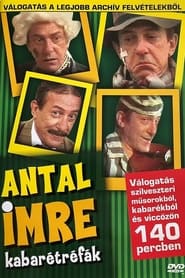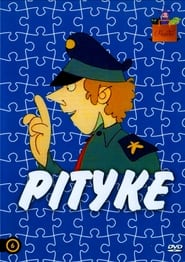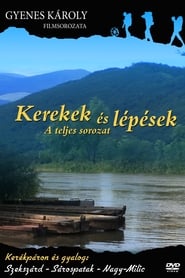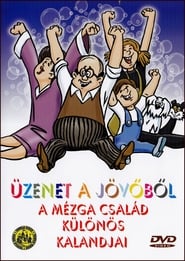Magyar Telev Iacute Zi Oacute TV Series
-
Szomszédok
1987
star 8.4Szomszédok was a Hungarian television series, occasionally called the Hungarian Dallas, that ran from 1987–1999 and produced 331 episodes, airing its grand finale on December 31, 1999. The series was a soap opera, dealing with the lives of ordinary people, living and working in or around an average lakótelep. Its characters were explored, over time, in equal depth: ranging from elderly pensioners, busy middle aged professionals, up-and-coming young people, and children growing into their teens. Many consider Szomszédok to be the definitive Hungarian television series, being a period piece of sorts that covers the last few years of the communist era, the rendszerváltozás, and nearly a decade of the new market economy Hungary thereafter. -
Kisváros
1993
star 6.6A Kisváros egy színes, 195 részes magyar akciófilm-sorozat, ami 1993–2001 között futott a Magyar Televízióban. A történet középpontjában egy, a valóságban nem létező határmenti kisváros, Végvár áll. Ebbe a városba érkezik Hunyadi főtörzs, hogy a Határőrség akciószázadát kiképezze. A sorozat a rendőrség és a határőrség határmenti bűncselekmények ügyében való nyomozások terén történő együttműködését mutatja be, minden epizód egy-egy önálló történet, a kiemelt főszereplőkké később Járai rendőr őrnagy és beosztottja, Balogh Máté zászlós válnak. -
Hungarian Folktales
1977
star 6.7Hungarian Folktales is a Hungarian animated series. Each episode is based on a Hungarian folk tale. The creators paid special attention to using Hungarian folk motives in the episodes. -
Mirr Murr a kandúr
1973
star 10We can follow the fairytale heroes of István Csukás, Mirr-Murr and Oriza Triznyák, the two curious stray cats on their adventurous journeys. The story of the puppet film begins with Kiscsacsi (whose name is Samu according to the original history of the book) getting to know the wardrobe, the bed, the chair, the chandelier and of course Mirr-Mur. Together they fly, play a naval battle, read a book, or just make friends with Paprikajancs, Bóbice, and Csinnadrata, the lead soldier with whom they discover the poultry farm. Mirr-murr accidentally left the others and ends up in Ödön Slukk's coat pocket. He manages to get out and then befriends Oriza Triznya. The two stray cats stand various rehearsals, help Pál Ploma or join a company called Pintyőke Circus World Number. Further stories will emerge from the series and books. -
The Mézga Family
1970
star 8The family consists of Géza, the father, a comical and inept figure, his wife Paula who actually dominates family affairs, pubertal daughter Kriszta and 12-year-old son Aladár, a child prodigy. The cat Maffia and a dog, Blöki accompany the family. Dr. Máris, their cynical neighbour, is regularly and unvoluntarily involved in disasters surrounding the family. -
Kérem a következőt!
1975
star 5.6Dr. Bubó is a short-eared owl who, after obtaining his medical degree with excellent qualifications , sets up his clinic inside an oak tree, where he heals the sick inhabitants of the forest with the help of his assistant - the nurse of the clinic - Nurse Ursula. -
Pityke
1981
star 8Pityke is a Hungarian animation about Hungarian police and funny crime stories for children and the young. -
Hofi Tükre (DVD)
0000
Hofi Tükre (DVD)
0000
-
Gustavus
1966
star 10Gusztáv, also known as Gustavus, was Hungarian series of animated short cartoons for adults. It was extremely popular in Eastern Europe, where it has achieved cult status. It ran from 1964-1977. Each episode tells an adventure of the main character, Gustav, related to the gray realities of urban life. Characteristic feature of the show was that episodes were independent: for example, Gustav is sometimes a bachelor, sometimes has large family. In Eastern Europe and Yugoslavia the episodes were broadcast on TV in the 80s, usually as airtime filler. The series was also broadcast in Western Europe and even in New Zealand - because it was not using language, other than gibberish sound, it was able to easily transcend boundaries. -
Legacy from the Future - Fantastic Adventures of Family Mézga
1970
star 6.7Geza Mezga, Paula, teenager Kriszta their daughter and the restless little child, Aladar. So they are the Mezga family. Maybe Maris neighbour should also be counted here. They are always embroiled in extremely strange adventures, thanks to their "distant" relative, MZ/X discovered by Aladar. With the help of Aladar's own radio transceiver, they get in touch with their thirtieth-century relative. Incredible things happen suddenly in an otherwise ordinary family. -
Captain Tenkes
1964
star 5.2During the Rákóczi's War of Independence in South Baranya, in Vienna, Colonel Eberstein is assigned by the Council of Warriors to dispose of the Kuruc army operating in the vicinity of Siklós. -
Sobri, ponyvafilm
2002
Sobri, ponyvafilm
2002
-
The rabbit with checkered ears
1974
star 6.5A kockásfülű nyúl (English: "The rabbit with checkered ears") is a 26-episode Hungarian animated children's series produced from 26 August 1977 on in the studios of PannóniaFilm. Created by the acclaimed children's literature writer and graphic artist Veronika Marék and animator Zsolt Richly, its protagonist, the rabbit with checkered ears quickly became one of the most prolific mascots of Hungarian animation.



















